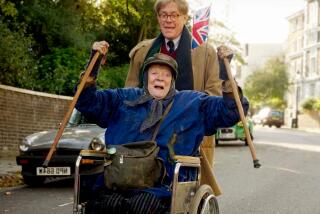Jimmy Smith, 76; Broke New Ground in Jazz With the Hammond Organ
- Share via
Jimmy Smith, the reigning “Emperor of the Hammond Organ” who was widely credited with turning it from a novelty instrument in jazz to a legitimate option for keyboard players, has died. He was 76.
Smith was found dead at his home in Scottsdale, Ariz., on Tuesday afternoon by his business manager, Robert Clayton. The cause of death was not immediately known.
Smith had been working regularly in recent months and was preparing for a national tour with friend and fellow organist Joey DeFrancesco, to promote their Concord release, “Legacy,” due out next week. Smith’s last club appearance in Los Angeles, a date that included DeFrancesco, was in December at Catalina Bar & Grill.
“Jimmy was one of the greatest and most innovative musicians of our time,” DeFrancesco said Wednesday in a statement released by Concord. “He was my idol, my mentor and my friend.”
Although Smith didn’t introduce the organ to jazz, he is credited with breaking new ground with it in more than five decades at the keyboard. His hard-driving bebop and blues sound spawned a thousand would-be imitators, including Jack McDuff and Jimmy McGriff.
“He had a real genius,” said guitarist and educator Kenny Burrell, who played with Smith on more than a dozen recordings, both as a sideman and as a leader. “If you think about the jazz greats on instruments -- Miles [Davis], Charlie Parker and [John] Coltrane -- Jimmy was in that league. There were jazz organists before him, but he put it on a level with those jazz greats.”
Smith was born in Norristown, Pa., on Dec. 8, 1928; various references list his year of birth as 1925, but Clayton and family members say it was three years later. He learned the rudiments of piano and bass from his father, who played stride piano.
Smith quit high school and served in the Navy during World War II. After the war, he used the GI Bill to attend several top music schools in Philadelphia, where he studied bass, piano and composition.
He played piano in local R&B; groups in the late 1940s and early ‘50s. But while on a visit to Atlantic City, he heard Wild Bill Davis playing organ in a swing band and was immediately captivated.
“When he finished playing, I snuck up on the bandstand to touch the action,” Smith told Down Beat magazine some years ago. “It was so soft. I knew I could play it.”
Smith later said he borrowed money from a loan shark in 1954 to buy his first Hammond. He spent months learning the instrument, setting up a practice space in a Philadelphia warehouse, where he developed a lightning-fast blues and bebop-oriented sound. He would say that his sound was influenced more by the great saxophone sounds of Illinois Jacquet, Arnett Cobb and Gene Ammons than by any keyboardist.
In the Down Beat interview, he explained his attraction to the organ.
“The Hammond has body. It’s got depth -- and resonance. It’s got clarity -- and quality. And you can feel it. It’s not so much that you can hear it. It’s the feeling that’s important,” Smith said. “You see, it’s like a drummer. You don’t want to hear him. You want to feel him. You can have the best drummer in the world, but if he’s too loud, he’s out of place. With the Hammond, you feel it in your bones.”
He formed his first trio in September 1955 and started with club dates in the Philadelphia area. His debut in New York at the Club Bohemia in 1956 drew interest by many musicians at the time. Impressive performances at Birdland in New York City and at the Newport Jazz Festival followed.
Smith was quickly signed to a record deal with Blue Note. His first album, “A New Sound, A New Star: Jimmy Smith at the Organ,” signaled the arrival of a major talent.
He recorded 30 albums for that label before leaving in 1962. Those sessions, which included collaborations with Burrell, Lee Morgan, Lou Donaldson, Jackie McLean and Stanley Turrentine, were extremely influential in establishing Smith and the Hammond B-3 as influential in jazz.
After leaving Blue Note, Smith recorded for Verve for several years. Many of those albums were bestsellers and included big bands and the arrangements of Oliver Nelson. Burrell played on several of those sides.
“Harmonically, I never knew what he would throw at me. It was always exciting and adventurous,” Burrell, now the director of the jazz studies program and a professor of music and ethnomusicology at UCLA, told The Times on Wednesday. “He was an inventive, creative genius, and his sound never got old.”
Smith toured nationally and internationally, and recorded for several labels throughout most of the next two decades.
He settled in Los Angeles in the 1970s, and in 1976, he and his wife, Lola, opened Jimmy Smith’s Supper Club in the Valley. The club closed several years later, and the Smiths left Los Angeles. They settled in Arizona a year ago, and Lola died a few months later of cancer.
Interest in the Hammond has risen and fallen over the last two decades, but Smith was always considered the reigning king of the instrument.
“The ideal in jazz is to hit a groove and stay in it,” jazz critic Nat Hentoff told The Times on Tuesday. “He had all that power in his playing, and he was always in the groove.”
His survivors include two daughters, a son, a stepson and two sisters. Funeral arrangements are pending. Smith will be buried in Norristown, Pa.
More to Read
The biggest entertainment stories
Get our big stories about Hollywood, film, television, music, arts, culture and more right in your inbox as soon as they publish.
You may occasionally receive promotional content from the Los Angeles Times.








